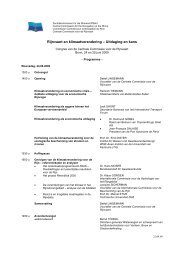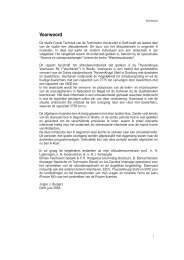ARgonon, susTAinAblE ship - Informatie Binnenvaart
ARgonon, susTAinAblE ship - Informatie Binnenvaart
ARgonon, susTAinAblE ship - Informatie Binnenvaart
- No tags were found...
Create successful ePaper yourself
Turn your PDF publications into a flip-book with our unique Google optimized e-Paper software.
CBRBThe regulationsCBRBVasteland 12e3011 BL RotterdamT +31 10 798 98 00E cbrb@binnenvaart.nlW www.cbrb.nlThe Centraal Bureau voor de Rijn- en <strong>Binnenvaart</strong> or Dutch Central Bureau forRhine and Inland Navigation (CBRB) is an association in more than one sense.Of course, its legal status is that of an association, but there’s more to it thanthat. The CBRB unites the most diverse professional groups and companies ininland navigation. That is possible only if the organization is structured insuch a way that all of these different entrepreneurs and companies arecertain that their sometimes conflicting interests are optimally served. It hasto be a very special organization – and it is.The multifaceted nature of the CBRB is a reflection of the industry that theassociation represents. Based on water-borne transport, the core of CBRB’smember<strong>ship</strong> are <strong>ship</strong>-owners. These range from bargemen with one <strong>ship</strong>transporting sand, a newly built tanker or container <strong>ship</strong>, to <strong>ship</strong>pingcompanies with tens of tankers or more than a hundred lighters. Amongothers, there are 250 independent <strong>ship</strong>-owners in the CBRB.Moreover, there are companies that are members of the CBRB that actuallydo not have their own fleet but carry responsibility for the organization andmanagement of transport chains, such as operators, cargo brokers and otherlogistical service providers. Apart from the fact that the companies are verydiverse, there is also great diversity in the market in which CBRB membersoperate: ferry services, towing services, container transport, large-scalelighter transportation, sand and gravel transportation, passengertransportation and dry bulk.The dividing line between the various groups is not always clear. Forexample, an operator may own a number of <strong>ship</strong>s and also be the client of agroup of independent contractors. This calls for a high level of flexibility onthe part of CBRB staff.All cargo vessels sailing on inland waterwaysin Europe must follow regulations.This seems logical now, but it has notalways been the case. First of all, hereare a few boring dates.Let’s go back to 1816. August 15th ofthat year saw the first meeting of theCentral Commission in Mainz. On March31st, 1831, the Convention of Mainz wasadopted. This was the first Rhine NavigationTreaty which set down uniformlegal principles for Rhine Navigation.The convention also contained a greatmany police regulations. So there’snothing new under the sun – then too,a lot of discussion took place before anagreed document was finalized. The firstregulations concerning the transport ofhazardous substances were adopted in1838. These were regulations governingthe transport of gunpowder. The firstRhine Navigation Police Regulations sawthe light of day in 1850. In 1861 theCommission moved from Mainz to Mannheim,following which, the Convention ofMannheim was signed on October 17th,1868. The majority of the stipulations ofthis convention still apply to navigationon the Rhine. 1900 saw new stipulationsfor the transport of corrosive and poisonoussubstances and in 1905 these werefollowed by stipulations for the transportof petroleum and refinery products. Soan embryonic ADNR was already there,although it would still take many yearsto evolve into its present form. In 1904,the first Regulations for the Investigationof Ships on the Rhine (Reglement OnderzoekSchepen op de Rijn) were adopted.This also established the foundationsfor the regulations on the transport ofhazardous substances. Then World War Itook place and, as befits the victors, thearmistice was followed in 1919 by thesigning of the Treaty of Versailles, whichincluded a number of new rules for theCommission. One of the consequences ofthe war was that the Commission wouldno longer reside in Mannheim. In 1920,it was moved to Strasbourg and housedin the former imperial palace, whichfrom then on would also be known asthe Palais du Rhin. This palace was builtbetween 1884 and 1888 to a design byHermann Eggert. It was built in a neorenaissancestyle as a residence for theGerman Emperor Wilhelm II for his visitsto Alsace-Lorraine, which was a Germanpossession at the time. Up to 1914, hevisited the palace only five times. Withthe move to Strasbourg, a permanentsecretariat was also appointed. The firstRegulations for Rhine Navigation Permits(Reglement Rijnschipperspatenten) followedin 1922 and then everything wentquiet for a long time. This was partlydue to World War II but the work of theCentral Commission resumed after theliberation in 1945. In 1963, the Conventionof Strasbourg was signed, which madea number of amendments to the Conventionof Mannheim. 1968 saw the firstregulations for the use of radar by bargesand in 1971 – no less than 66 years afterthe last amendment – finally the firstever ADNR, which entered into force in1972. But after this, amendments camepretty quickly. In addition to normalchanges, sweeping changes were madeto the Regulations for the Investigationof Ships on the Rhine and the ADNRin 1976 and 1995. The ADNR was alsoradically changed once again in 2003. In1979 there was also a second additionalprotocol to the Convention of Mannheimthat set down stipulations regarding thequalification of <strong>ship</strong>s for Rhine navigation,in 1989 a fourth additional protocolregarding structural reorganizationand in 1999 a fifth additional protocolregarding the “old-for-new” rule. 1998also saw the adoption of further RhineNavigation Police Regulations and alsoRegulations for Rhine Navigation Permitsthat were adapted to technical developments.The reason why there wereregular amendments to the regulationsfrom the nineteen-seventies onwardshas to do with the formation of a largenumber of working groups that adapt theregulations to the current state of technology.We now know that, in additionto the regulations listed above, Europeanregulations have also applied for a numberof years. For example, there is theEuropean Directive 2006/87/EG. As thedate suggests, this entered into force in2006. The text of the directive is almostidentical to that of the Regulations forthe Investigation of Ships on the Rhine.In Europe, there is also a FrameworkDirective for the transport of hazardoussubstances. According to this directive,all vessels transporting hazardous goodsin Europe must satisfy the stipulations ofthe ADN. This ADN replaced the ADNR onJanuary 1st, 2011. Fortunately you canchoose whether a vessel should satisfythe RISR or the European Directive.Both regimes allow transportation onEuropean inland waterways. If we nowwish to deviate from one of the rulesmentioned above, we have to apply forso-called equivalence. In the event ofsuch an application, we have to showthat the alternative design is just as safeas the prescribed one. For example, a lotof applications are now being submittedfor using a different fire-extinguishingsubstance in fixed fire-extinguishinginstallations to the one stipulated inthe regulations. Such an application hasalways to be submitted for each vesselindividually until the time when theregulations have been adapted to thenew substance. In the case of a differentfuel, such as LNG, you have to show thatits use is not more hazardous than thediesel allowed today. In the case of anapplication for equivalence to the CCRin Strasbourg, the application has to beapproved by all member states. If not,negotiations will have to continue untilapproval is granted. In the case of theEuropean Directive and the ADN, approvaldepends on a majority of votes butbecause the same people sit on all threecommittees, permission will depend onapproval in Strasbourg. This is usually along-term procedure and you should notexpect a result from one or two meetings.So the first organization to applyfor such equivalence has to invest a lotof patience as well as money. It’s theneasier for the next one though. Whenapplying for equivalence it is importantthat all the pros and cons are examinedand that solutions are put forward forthe disadvantages. Well-substantiatedresearch, with the help of a classificationbureau, for example, is a goodinvestment. Although, in demonstratingequivalence for the Argonon, we believethat we have done everything we can todemonstrate equivalent safety, a lot ofquestions are still being asked by variousdelegations. These too must be answeredsatisfactorily and this will finally lead toequivalence being granted. But our workwill not end there. One of the conditionsis that there will be annual evaluationsthat are then assessed by the memberstates. However, let us hope that thechanges to the regulations will go quickerthan in the early days of regulationsfor inland navigation, otherwise we willsoon lag behind road transport and thatis something that we certainly do notwant.argonon, First inland barge on dual fuel




